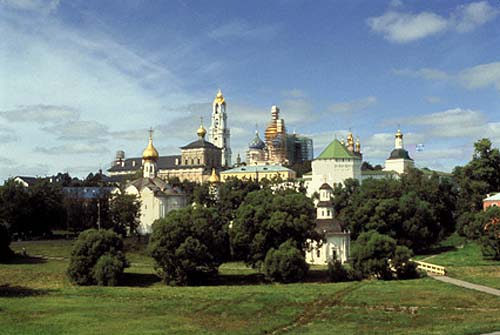
Monastery of Sergiev Posad
Sacred Sites of Russia
Christianity became the religion of Russia in 988 AD but for uncounted centuries there had already been a variety of megalithic, pagan and shamanic traditions active from the Baltic Sea across Siberia to the Sea of Okhotsk. Given this vast expanse of land, there were innumerable cultural and religious influences that developed over the ages. Concentrations of megaliths, dolmens and stone labyrinths have been found (but little studied) along Russia’s northern shores with the White Sea and the Barents Sea as well as throughout the Caucasus mountains. The region north of the Black Sea was settled around 700 BC by the Central Asian Scythians, whose primary deities were the Great Goddess Tabiti (Hestia), her consort Papaeus (God of the Heavens), Apia, (the Earth Goddess), Argimpasa/Atimpaasa (Goddess of the Moon) and Oetosyrus (the Sun god). The Scythian empire ruled for around 400 years, after which various people including Huns, Greeks, Persians, Celts and Slavs introduced other deities and religious practices. The Slavs, occupying large parts of what are now Poland, western Russian and Ukraine, were nature worshippers and had deities such as Svarog (God of the Heavens and thunder), Dazbag (God of the Sun), Myesyats (Goddess of the Moon) and Jarovit (God of the sacred springs). The enormous Eurasian steppes were sparsely inhabited by nomadic peoples who continued to practice shamanic ways long after the introduction of Christianity in western Europe.
Scandinavian pagan influence entered the region of western Russia in the mid-9th century when the Slavs invited and assisted the Swedish Varangians (Vikings), who then established the first Russia state at Novgorod. After his baptism and marriage to a Byzantine princess, the Varangian King Vladimir I imposed Christianity on the Russians in 988. Following a practice long established by Roman Christianity, pagan temples were demolished and churches erected directly upon their foundations. Monasteries began to spring up across western Russia, amassing great riches and land holdings, even during the Tartar period (beginning in 1224) when monks and priests were exempt from the Tartar taxes. For a short period, from 1315 to 1377, the city of Kiev became Pagan again but by this time Russia was (and has continued to be) strongly Orthodox.
From its very beginning, Russian Orthodoxy was characterized by a thriving pilgrimage tradition. Strongly influenced by similar notions in Byzantine Christianity, Russian Orthodoxy believed that icons functioned as suitable imitations of Christ and the saints, and that relics had miraculous powers. While Protestantism would later abolish the practice of pilgrimage in many parts of Europe, Russian Orthodoxy encouraged the worship of icons and the tradition of pilgrimage as a way of life. In the 17th through 19th centuries tens of thousands of Russians, both peasants and educated city dwellers, went upon long walking pilgrimages to the great monastic centers in order to worship and behold the sacred icons and relics. The famous 19th century spiritual diary The Way of a Pilgrim provides a fascinating view into the lifestyle of a wandering pilgrim. The anonymous author writes:
I made up my mind to go to Siberia to the tomb of St. Innocent of Irkutsk. My idea was that in the forests and steppes of Siberia I should travel in greater silence and therefore in a way that was better for prayer and healing. And this journey I undertook, all the while saying my oral prayer without stopping.
During the Soviet period many monasteries were closed and churches destroyed. Since the end of that era the remaining monasteries and churches have been returned to the Russian Orthodox church, buildings are being reconstructed, religious services are again permitted, and pilgrims are arriving in greater numbers with each passing year.
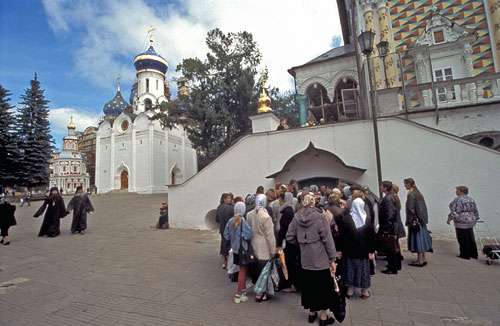
Pilgrims viewing relics at Sergiev Posad
Monastery of Trinity-St. Sergius Sergiev Posad
The grand monastic complex and church of Sergiev Posad, located 45 miles north of Moscow, is the center of Russian Orthodoxy and one of the most important places of pilgrimage in the entire country. (The center of Russian Orthodoxy was originally in Kiev, Ukraine but following the 13th century Mongol invasion, the patriarch moved to the town of Moscow in 1308). The first religious structures at Sergiev Posad were founded by the Russian nobleman Sergius (1319-92), also called Sergiev, who retired to the forest of Radonezh with his brother Stephen to lead a life of prayer. In 1340 (some sources say 1337) the two brothers built a small wooden church and the site began to attract other monks and a growing number of pilgrims. Rapidly developing into a monastic complex, the site was given the name Trinity Monastery.
Sergius the monk also became involved in politics. He helped to unite the feuding Russian prince to resist invasion by the Tartars and supported the Moscow prince Dmitrii Ivanovich who wanted to make Moscow the center of Russia. Epiphanii the Wise, a biographer of Sergius, tells of many miracles connected with the life of the saint. According to Epiphanii, Sergius experienced a miraculous appearance of the Mother of God, who promised everlasting protection to the Monastery. Epiphanii also described miracles that happened to people who called upon the name of St. Sergius. Because of his religious and political achievements, Sergius was canonized in 1422. His relics were placed in a silver reliquary in Trinity Cathedral, constructed between 1422-27, upon the site of the earlier wooden church (destroyed during a Tartar raid). The Cathedral was decorated by the most famous Russian icon painters, Daniil Chernyi and Andrei Rublev. The main object of worship in the cathedral are the relics of St. Sergius.
The monastery, church and reliquary of St. Sergius soon became a national symbol of Russian and Orthodox unity, inspiring resistance to the Tartars. In 1552, to celebrate the defeat of the Tartars, Czar Ivan Grozny (Ivan the Terrible) began construction of the Assumption Cathedral at Sergiev Posad. The Cathedral was later decorated in 1684 by 35 icon painters. By the middle of the 16th century St.Sergius monastery was remodeled into a great fortress, with walls 6 meters in height and 3 meters thick. In the beginning of the 17th century, the monastery withstood a 16-month siege by the Poles and the Lithuanians. The invaders had an army of 30,000, while the monastery numbered only about 3,000 defenders and this war demonstrated the great fortitude and spirit of the Russian people. Following this war, different Russian tsars, before embarking on their wars, made pilgrimage to the monastery and their armies carried icons with images of St. Sergius.
In 1682 and 1689 the monastery again became a center of Russian history. Tsar Peter I the Great took refuge within the fortress walls when the army rose in rebellion against him. As a token of gratitude he made further donations to the Monastery. In the final years of the 17th century many new buildings were erected within the monastic compound, including the Church of St. Sergius, the splendid Tsar Palace, and the Church of the Nativity of St. John the Baptist. Due to numerous donations the monastery became the largest and the richest in Russia, acquiring vast land holdings. Only the Tsar had more power.
In 1721 the patriarchate was suspended, the monastery lost most of its land and wealth to the state, and the church was governed by a council controlled by the Tzar. During Communist times, the remainder of the monastery’s properties were seized and the town was renamed Zagorsk after an important Communist leader. With the fall of Communism in 1991 Sergiev Posad regained its ancestral name and control of its own affairs. Extensive reconstruction and restoration projects are underway and large numbers of pilgrims visit the shrine each year. Within the 25 acre monastery complex are numerous churches and a pilgrimage route that visits the Icon of Our Lady of Smolensky, the tomb of St. Sergius and St. Sergius’ Well. The monastery is also the location of the main seminary school in Russia, the Moscow Theological Academy. More than 200 monks make their home at Sergiev Posad.
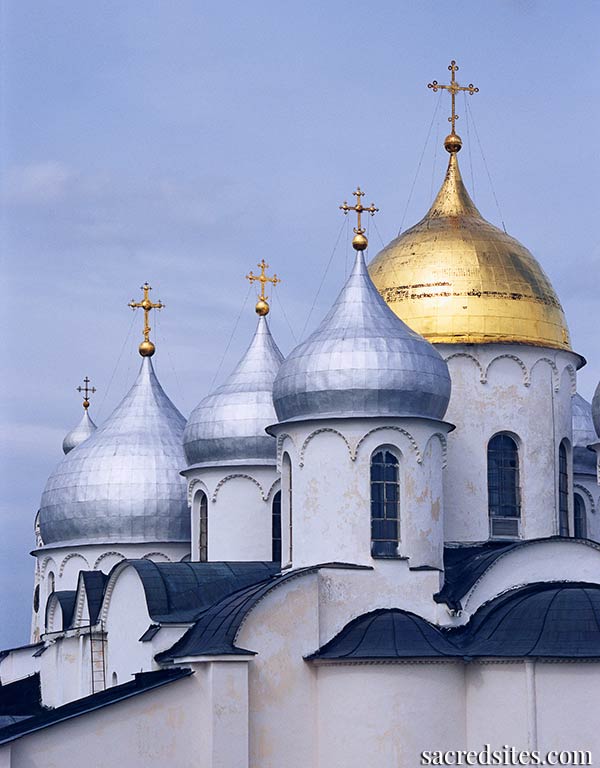
St. Sophia cathedral in Novgorod
Novgorod, one of the oldest cities in Russia, was founded in the 5th century AD on the shore of the Volkhov River. The first known church, erected upon the site of a pagan temple, was a small wooden structure built in 989. In 1045 this building burnt to the ground and upon the same site, a stone cathedral was built by the Novgorod Prince Vladimir Yaroslavovich in 1045-1050. The new cathedral was consecrated in 1052 to St. Sophia, who symbolized the feminine aspect of divine wisdom. Scholars interpret the dedication of Novgorod’s cathedral to St. Sophia (as also occurred with the great cathedrals in Kiev and Polotsk) as a continuation of a cult of the Great Goddess that was widely practiced in these regions since archaic times.
Over the next two centuries the St. Sophia cathedral became a main center of Christian spirituality in northern Russia. Initially the stone cathedral had a stark and somewhat ascetic appearance due to its lack of plastering and decoration. In the beginning of the 12th century, Greek icon painters began to decorate the inside of the building and over the passing centuries many more beautiful frescoes were added. While none of these early frescoes have survived, the actual building has preserved most of its original form.
In 1170 an event occurred that was to firmly establish the cathedral as a place of pilgrimage. An army from the city of Suzdal had attacked Novgorod and was threatening to overwhelm the inhabitants. The local bishop had a vision in which he was instructed to carry the icon of the Virgin to the fortress walls. An attacker’s arrow flew through the air and lodged directly in the icon, where upon tears began to flow from the Virgin’s eyes. At this moment, so the legend tells, all the attackers went blind and the army of Novgorod was able to easily defeat the enemy. Since this time the icon of the Virgin has been named Znamenie, meaning ‘Our Lady of the Sign’ and she is believed to be the protector of the city. Her festival is celebrated on December 10.
In the 13th and 14th centuries, Novgorod flourished as a trade outpost of the Hanseatic League and was a major cultural center. It repulsed Tatar invasions in the late 13th century but in 1478 was annexed by its rival, Moscow, under Ivan III. The city declined as a trading center after the establishment of nearby Saint Petersburg in 1703 but remained an important pilgrimage center until 1929 when the cathedral was closed by the Soviet government. During the Soviet period and the German occupation of 1941-44, the city of Novgorod was severely damaged and the cathedral was pillaged, bombed and left to deteriorate. Near the end of the Soviet period the cathedral was partially renovated, in 1991 it was returned to the Russian Orthodox Church, and since that time has undergone extensive restoration.
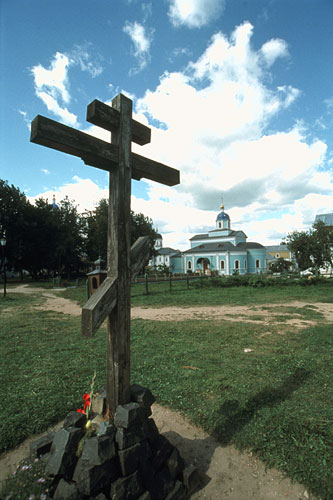
Monastery of Optina Pustyn
The monastery of Optina Pustyn is located on the right bank of the Zhizdra River two kilometers from the city of Kozelsk and about 70 kilometers south of Kaluga. According to legend, the monastery was founded in the 15th century by a former outlaw whose name was Opta. Repenting of his sins, he took monastic vows with the name of Makarii. The first historical evidence of the monastery comes from the 17th century, during the reign of Tsar Mikhail Feodorovich. At this time the monastery was only a small establishment, with one wooden church, several monastic cells and less than twenty monks.
During the end of the 18th century and the beginning of the 19th, the Monastery's income significantly increased and several new buildings were erected. This growth of the monastery was both stimulated by and contributed to the development of a tradition called Starchestvo, which means ‘a lineage of wisdom of prayer’ maintained by Staretz, these being Russian Orthodox monks or ‘Elders’ of deep wisdom. The roots of this movement are found in the Byzantine hesychia, ‘the art of silent prayer’ (14th –15th c.), which was introduced to Russia by St. Sergius of Radonezh and his successors. In the 16th-18th centuries the ecclesiastical life in Russia had increasingly become secular and political, and as a reaction against this worldliness the starchestvo tradition became widely popular among the Russian people. A primary, though unofficial, center of starchestvo in Russia was the monastery complex of Optina Pustyn.
In the 19th century many elders came from different parts of Russia to live and teach at Optina Pustyn. These elders shared their spiritual experience with both lay practitioners and the community of monks, they wrote and translated books, and ministered to the poor and sick. There were fourteen particularly wise elders during this period and the days of their death are commemorated with religious festivals at the monastery. The celebration of the whole council of the Optina elders is on 24 October. Optina Pustyn became a place of pilgrimage not only for a multitude of Russia's peasant wanderers but also for important cultural figures of the time. The writers Tolstoy, Gogol and Dostoevsky, as well as leading philosophers all received counsel from the Optina elders.
The Elder tradition at Optina Pustyn continued until the Bolshevist rebellion. In 1918 the Soviet Government closed the monastery and its churches, imprisoned numerous monks, and turned the complex into a museum in 1923. During the 1930’s, many of the monks were sent to Siberian labor camps, tortured and shot. The last Optina elder, Archimandrite Isaachlus II, was shot December 26, 1938. In 1987 Optina Pustyn was returned to the Orthodox Church and has since that time again become a celebrated pilgrimage destination.
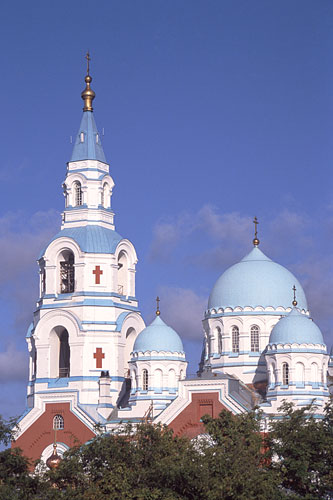
Monastery of the Transfiguration, Valaam Island
In the northern part of the Ladoga Lake, the largest lake in Europe, are situated numerous islands, the largest of these being Valaam with an area of approximately thirty-six square kilometers. The name Valaam is translated from Finnish as ‘the high land’ and sometimes the name of the island is also attributed to the name of the pagan god Baal or the biblical prophet Balaam. One Valaam legends tells that long time ago, before the Finno-Ugric and Slavic peoples inhabiting the shores of Ladoga Lake adopted Christianity, the island was a site of great pagan sanctity. In the southern part of the main island rises Snake Mountain, also called Karmil Mountain, where once stood altars to different pagan gods. Christian legends say that in the 1st century AD, one of Christ's disciples, St. Andrew visited Valaam where he destroyed the pagan altars and erected a stone cross, but there is no historical evidence to confirm Andrew’s visit.
The Christian history of Valaam really begins in the 10th century with the arrival of two monks named Sergius and German. Around these two monks grew a thriving monastic community. During the next several centuries Swedish pirates and soldiers repeatedly attacked the monastery, with reconstruction following each desecration. In 1163 the relics of Sergius and German were removed to Novgorod for safe keeping but were returned in 1180 and have since that time been buried in a deep rock chamber beneath the church. Monastery chronicles tell of numerous miracles performed with the relics, of their ability to save people from drowning and freezing in the lake, and that prayers addressed to the relics heal nervous, mental and infectious diseases, as well as alcoholism.
In 1617 the island was given to Sweden but was returned to Russia in 1721. In 1719 the wooden Cathedral of the Transfiguration was built above the tomb of the saint’s relics but three fires during the early 1700’s destroyed all the wooden buildings. In 1755 the five-domed Cathedral of the Transfiguration was consecrated again and Valaam entered a period of favorable times during which enterprising abbots greatly enlarged the monastic complex. From 1917 to 1940 the island was under the jurisdiction of Finland and the Cathedral and monastic buildings suffered oblivion and gradual decay. From 1940 until 1990 the Russian government used the island for military exercises and lodging for disabled soldiers, and in 1991 the old monastic properties were returned to the Orthodox Church. Since that time monasticism has experienced a new birth on Valaam and each year many thousands of pilgrims journey to the island to experience the miraculous relics and spend time in spiritual retreat. Special holy days, the commemoration day of St. Sergius and St. German on July 11, and the Feast of the Transfiguration of the Savior on August 19 attract larger numbers of visitors. Valaam island is also a place of great natural beauty with virgin forests, rocky shores and more than 400 varieties of plants.
Icons for sale, monastery of Sergiev Posad
Other sacred sites and power places in Russia:
- Ipatevsky Monastery in Kostroma
- Solovyetsky Monastery, Solovets Island
- Pechorsky Lavra, near Pskov
- Seraphimo-Diveeno monastery
- Shamordino Poustyn nunery
- Zadonsk monastery
- Sanaksarsk monastery
- Kizhi island
- The grave of St. Ksenya Blazhennaya in St. Petersburg.
- Suhaya Mountain, near Lake Tibercul, Siberia
- Holy mountains of the Kharkov province
- Megaliths and stone labyrinths of the Solovetski islands
- Megaliths on the Tersk shores, southern Kola peninsula
Important monasteries in Russia
- Tikhonova Pustyn (Panfutievo-Borovskii Monastery); Near the town of Kaluga. Founded in the 15th century by St. Tikhon. By the beginning of the 20th century it was one of the largest monasteries in Russia. Visited by thousands of pilgrims, it is famous for its medicinal holy spring.
- Davidova Pustyn (Svyato-Voznesenskaya Davidova Pustyn); 80 kilometers from Moscow. Founded in 1515 by St. David Serpukhovskoi.
- Nilo-Stolbenskii Monastery (Nilova Pustyn); Near the town of Ostaskov. Founded in the 16th century by St. Nil who had the gift of prophecy. In 1995 St. Nil's relic were given back from the Voznesenskii Cathedral of Ostashkov. The Monastery has a celebration in the beginning of June.
- Tolgskii Monastery; Near the town of Yaroslavl. In 1314 St. Prokhor was given the Tolgskaya icon of the Mother of God. Both the Monastery (male) and the Convent (female) are being reconstructed since the end of the Soviet era.
- Aleksandro-Svirskii Monastery; Near St. Petersburg. Founded by Alexander, a monk from Valaam monastery, in 1484.
- Novodevichii Convent (female); In Moscow. Founded by Prince Vasily III in 1524. The oldest church (1524) is dedicated to Our Lady of Smolensk. The main objects of worship are the icons of Our Lady of Smolensk and Our Lady of Iversk.
- Borisoglebskii Monastery; In the city of Dimitrov. Founded in the 15th century. Borisoglebskii Cathedral was constructed in 1537.
- Bogoyavlenskii Staro-Golutvin Monastery; Near the city of Kolomna. Founded in 1374 by St. Sergius of Radonezh and Moscow Prince Dmitry Donskoi.
- Svyatotroitskii Staro-Golutvin Convent (female); Near the city of Kolomna. Founded in the 15th century.
- Voskresenskii Novoierusalimskii Monastery; Near Moscow. Founded in 1656. The Cathedral of Resurrection was built in 1658-1685.
- St. Trinity Belopesotskii Convent (female); Near the city of Kashira. Founded in 1498. In the 16th- 17th centuries the Convent had a strategic importance and participated in several battles. It was opened again in 1993.
- Pokrovskii Khot'kov Convent (female); Near the city of Khot'kov. Founded in 1308. St. Sergius of Radonezh became a monk here. There are four different icons of the Mother of God kept in the Cathedral of the Protecting Veil (1810).
- Iosifo-Volotskii Monastery; Near the city of Volokalamsk. Founded by the miracle working St. Joseph of Volotsk in 1479.
- Nikolo-Ugreshskii Monastery; Near the city of Dzerzhinsky. Founded by Prince Dmitrii Donskoi in 1381. Main object of worship was the miracle-working icon of St. Nicolas, created in 1380. Great St. Nicolas Cathedral, built in the 14th century, was destroyed in 1940. Now the main church is the Transfiguration Cathedral (1880-1894).
- Ferapontov Luzhetskii Mozhaiskii Monastery; Near the city of Mozhaisk. Founded by St. Ferapont in 1398. Main object of worship was the relic of St. Ferapont relic. The Cathedral of the Nativity of the Mother of God was built in the 16th century). Opened again in 1993.
- Vysotskii Serpukhovskoi Monastery; Near the city of Serpukhov. The place for the Monastery was chosen by St. Sergius of Radonezh. In the 16th century the monastery was greatly favored by the Russian tsars who made rich donations. The Cathedral of the Conception of the Virgin was built in the 16th century.
- Svyato-Ekaterinenskii Monastery; Near the city of Vidnoe. Founded by Tsar Alexey Mikhailovich in 1658. During Soviet times the monastery was used as a prison but has been revived since 1992.
- Uspenskii Svenskii Monastery; In Bryanskoblast. Founded in 1288 by Chernigov Prince Roman Mikhailovich. A legend says he was blind and recovered his sight in front of the icon of Our Lady of Pechyora. At that place he founded the monastery. The main building is the Church of Candlemas (1679). The Assumption Cathedral was destroyed during Soviet times but is being reconstructed.
- Ioanno-Bogoslovskii Monastery; In Ryazan oblast. Founded in XVI century. The monastery had the famous St. John of God icon that prevented cholera in 1848 and 1892, stopped a fire in Poshchupovo village, and healed many pilgrims. Main building is the Cathedral of St. John of God (1689). Opened again in 1989.
- Svyato-Bogorodichnyi Shcheglovskii Convent (female); In the city of Tula. Founded in 1868. The main objects of worship were the relics of St. Panteleimon, St. Evfimii, St. Ignatii, and St. Akakii, a piece of the True Cross, and the Mother of God icon.
- Spaso-Yakovlevskii Dmitriev Rostovskii Monastery; Near the city of Rostov. Founded in 1389 by St. Jacob. The main objects of worship were relics of St. Jacob and St. Dmitry of Rostov. Main building is the Cathedral of the Conception of the Virgin (1686).
- Svayto-Danilov Monastery; First monastery in Moscow. Founded by Moscow Prince St. Daniil in 1282.
- Svyato-Troitskaya Aleksandro-Nevskaya Lavra; In St. Petersburg. Founded by Peter I the Great in 1710. Main object of worship is the relic of St. Alexander Nevskii. Many outstanding Russian people are buried on the territory of the monastery. The biggest church is St. Trinity Cathedral (1786).
www.radrad.ru/new/sheduleInfo.asp
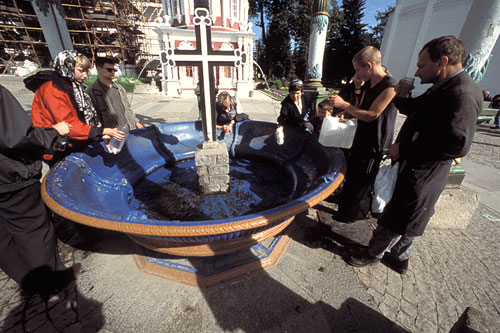
Pilgrims drinking and saving holy water, monastery of Sergiev Posad
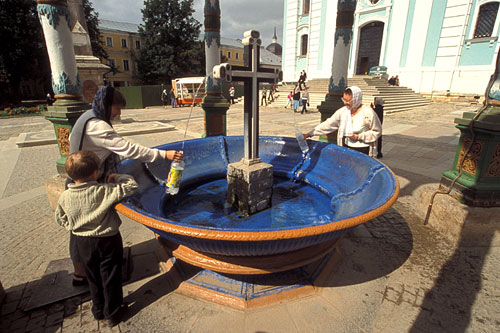
Pilgrims drinking and saving holy water, monastery of Sergiev Posad
 Martin Gray is a cultural anthropologist, writer and photographer specializing in the study of pilgrimage traditions and sacred sites around the world. During a 40 year period he has visited more than 2000 pilgrimage places in 165 countries. The World Pilgrimage Guide at sacredsites.com is the most comprehensive source of information on this subject.
Martin Gray is a cultural anthropologist, writer and photographer specializing in the study of pilgrimage traditions and sacred sites around the world. During a 40 year period he has visited more than 2000 pilgrimage places in 165 countries. The World Pilgrimage Guide at sacredsites.com is the most comprehensive source of information on this subject.